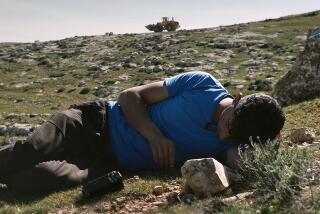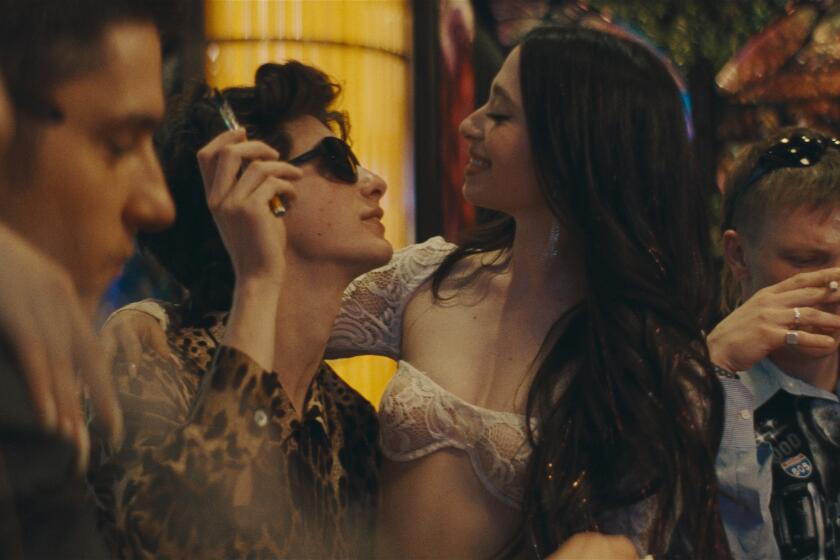There at the Creation
- Share via
Movies have always been a disposable commodity, a throw-away art form. Often as not nobody thought to save anything, up to and including the films themselves, unceremoniously dumped in the Pacific to save space.
That same indifference about preservation extends to modern books and documentaries that deal with motion pictures. Classic volumes on film fall out of print and stay that way, and docs, difficult to see under the best of circumstances, are even harder to catch up with when television decides the thrill is gone.
There are signs, however, that this attitude is changing. “Picture,” Lillian Ross’ unequaled account of the filming of John Huston’s version of “The Red Badge of Courage,” has recently returned to hard covers, courtesy of the Modern Library. And now, in a coincidence that’s little short of miraculous, a pair of the glories of film commentary and scholarship have almost simultaneously been put back into circulation.
On the print side, two of the American Film Institute’s legendary, one-of-a-kind catalogs, out of print for decades, have just been reissued by the University of California Press. These massive volumes, on the 1920s and 1960s, so avidly sought by knowledgeable film folk that they became all but unobtainable on the used-book market, turn out to be every bit as vital and exciting as anticipated.
The same is true for “Hollywood,” an exceptional 13-part documentary look at the world of American silent film written, produced and directed by Kevin Brownlow and David Gill.
Brownlow and Gill have no peers as makers of documentaries on the silents, and many PBS viewers are familiar with their studies of the great masters, including “Unknown Chaplin,” “Buster Keaton: A Hard Act to Follow,” “Harold Lloyd: The Third Genius” and “D.W. Griffith: Father of Film.”
But many fewer people have seen “Hollywood,” Brownlow and Gill’s first work and arguably the most important and entertaining documentary on the movies ever made. Completed in 1979, this thorough and compelling series, an instant university on the silent era, has been shown on U.S. television before, but only in a sporadic, scattershot fashion.
But now Turner Classic Movies, which showcased Brownlow and Gill’s latest series, “Cinema Europe: The Other Hollywood” last year, is doing once-a-week broadcasts of all 13 60-minute episodes of “Hollywood,” starting on Saturday at 4 p.m. The hour may be awkward, but the rewards are almost uncountable.
As with all great ventures, fortunate timing played a part in Brownlow and Gill’s success. When they arrived in Hollywood in the late 1970s, many veterans of the silent era were alive but ignored by American journalists and critics. Willing to talk to these knowledgeable and enthusiastic Englishmen, the pioneers left a glowing record of Hollywood in the 1920s, a record that has become increasingly irreplaceable as the years have passed. Even the series’ urbane narrator, sound film star James Mason, has been dead for more than a decade.
All told, Brownlow and Gill interviewed more than 70 survivors of Hollywood’s silent era. Of course there were stars like Gloria Swanson, Mary Astor, Lillian Gish, Louise Brooks, Bessie Love and Blanche Sweet. And a pantheon of directors including Frank Capra, George Cukor, Allan Dwan, Henry Hathaway, Howard Hawks, Henry King, Mervyn LeRoy, Lewis Milestone, King Vidor and William Wyler.
But what makes “Hollywood” special is the range of people it talks to, from legendary stuntmen Yakima Canutt and Harvey Parry to wry writer Adela Rogers St. Johns and Karl Brown, who assisted D.W. Griffith’s cameraman Billy Bitzer and makes the hair rise on the back of your neck with his eyewitness description of how Bitzer lit “Intolerance.” It is just this “you are there” immediacy, combined with Brownlow and Gill’s superb selection of vintage clips, that gives “Hollywood” its enduring power.
To hear, for instance, Viola Dana, one of the silent era’s great beauties, describe watching the love of her life, celebrated stunt pilot Ormer Locklear, plunge to his death before her eyes, is a privileged moment of a type that will never come again. Ditto for Olive Carey’s moving description of how John Wayne came to pay tribute to her husband, western star Harry Carey, with his left-hand-on-right-arm stance at the close of “The Searchers.”
What “Hollywood” finally accomplishes sounds close to impossible. It creates an irresistible excitement about those long-gone silent films, allowing us to feel the emotion they were made with and the impact they had. It shows why people cared about them so deeply then, and why we can and should now as well. When Douglas Fairbanks Sr. walked onto a sound stage and said, a friend recalled, “the romance of motion picture making ends here,” no viewer of this remarkable series will be tempted to disagree.
What Brownlow and Gill did on film, the hefty AFI catalogs accomplish on the page. The newly reprinted volumes recapitulate with intoxicating thoroughness two separate eras in all their fascinating diversity. The quality historian Arthur Schlesinger Jr. described on their initial publication, the ability to be “endlessly absorbing as an excursion into cultural history and national memory,” are still very much in evidence.
Though the American Film Institute is involved to varying degrees in a film school, a film festival and a life achievement award, these catalogs and their compilation of every single film released domestically may yet prove the AFI’s most lasting contribution to the culture of film. Enormous and resplendent in their red library binding, these books have a wealth of information and organization that makes them masterpieces of serendipity that can be contentedly browsed for hours on end.
Both the 1921-1930 two-volume set, published in 1971, and the 1961-1970 two-volume set, published in 1976, were originally brought out by R.R. Bowker, who also took charge of the books dealing with the era from 1893 to 1910 before tiring of the project.
The lively University of California Press, however, exhibited no such weariness. It published the AFI volumes for the teens and the ‘30s and is about to launch the catalog’s latest accomplishment, “Ethnic-American Feature Films 1911-1960,” to complement its reprinting of the 1920s and 1960s series. These books do not come cheap (the ‘20s and ‘60s books cost $300 per set, the ethnic volumes $150, available from the press at [800] 777-4726) but they can be consulted at libraries and no one who can afford them will regret the purchase.
The best way to appreciate the 1,600-page 1920s set or the 2,200-page 1960s books is to simply open them up at random and start scanning. The AFI catalogs are intensely indexed, making it possible to look up an obscure favorite actor, like silent comic Max Davidson, and marvel at how many films he made.
The subject indexes are especially fascinating. The ‘20s, for instance, had huge entries for films about band leaders, chorus girls and safecrackers, as well as (you read it first here) four films that deal with costermongers. The index for the swinging 1960s, by contrast, has huge entries for nudism, nymphomania and rape. None dare call it progress.
Most fun of all is to turn to the main body of the catalogs and browse the film titles and plot summations. In titles alone the 1960s boasted a daunting run of “Psychedelic Sex Kicks,” “The Psychic Lover,” “Psycho-Circus,” “The Psycho Lover,” “The Psychopath,” “Psychout for Murder” and, finally, “Psychoissimo.”
And for plot summaries, it’s hard to improve on this one for 1929’s “East Side Sadie”: “A Jewish sweatshop seamstress contributes her meager earnings to her boyfriend’s college education, but he falls into the hands of a marriage broker, who matches him with a wealthy girl. Given a beating by the seamstress’ brother just before the wedding, the boy awakens to the girl’s sacrifice and is reunited with her. (Sources are somewhat confusing about the story line. The boy may be Irish and have a Jewish stepfather. There is also a vague reference to a comedy scene on a tenement roof involving some Italians. Sound sequences include singing children, a cantor singing a wedding prayer, and some shouting during the wedding.)”
Yes, it’s true. They don’t make them like that anymore.
More to Read
Only good movies
Get the Indie Focus newsletter, Mark Olsen's weekly guide to the world of cinema.
You may occasionally receive promotional content from the Los Angeles Times.











